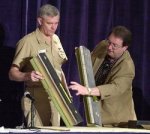
Wednesday, March 26, 2003 3:50
New Clues In Columbia Probe

The way metal melted in debris from the space shuttle Columbia indicates the leading edge of the shuttle's left wing experienced the hottest temperatures, perhaps offering clues as to where fiery gases penetrated the spacecraft, experts said Wednesday.
"This part of the leading edge saw the hottest heat," Mark Tanner, a mechanical engineer told members of the Columbia Accident Investigation Board during a second day of hearings. "I think this tells us a small story."
Molten metal is much more apparent on panels from the left wing than the right wing, said Gregory Kovacs, a professor of electronics at Stanford University, who is studying the debris for investigators.
"You see more deposits. You see deposits that are different in character," Kovacs said of the left wing. "If you look at the right wing, the panels are pretty clean."
Pieces from the left side also show more signs of erosion and degradation, Tanner said.
About 54,000 pounds, roughly a quarter of the orbiter's weight, has so far been recovered. Of the 45,000 pieces, only about 1,400 pieces, have been laid out in place on a grid in a hangar at the Kennedy Space Center.
Workers hope to make a reconstruction of the shuttle with the parts to help investigators understand what happened to Columbia
Parts from the shuttle's left wing get top priority, said Steven Altenus, shuttle test director at Kennedy Space Center, who is in charge of the reconstruction.
Investigators believe a section of the left wing was breached by fiery gases during Columbia's re-entry. Little of the left wing's aluminum structure has been recovered.
One theory investigators are exploring is that the wing may have been damaged by foam insulation falling from the external fuel tank during liftoff on January 16.
Teams searching Texas and Louisiana for debris from the space shuttle Columbia have only a few more weeks before spring growth of brush and trees makes it difficult to find more pieces, NASA officials told board members Wednesday.
About 5,700 people are still searching the primary debris field, an area that stretches about five miles by 250 miles across the two states, for parts from the shuttle. The Columbia broke up on reentry February 1, killing all seven crew members.
Officials studying videotape of the shuttle's destruction believe other debris may have fallen in the snowy mountains west of Texas, though no shuttle debris has yet been found there.
"Our intention is to press on and not worry much about conditions," Mike Rudolphi, deputy director of Stennis Space Center in Mississippi and leader of NASA's efforts to recover debris, told board members.
Copyright © 2003 The Associated Press. All rights reserved. The information contained in the AP News report may not be published, broadcast, rewritten or redistributed without the prior written authority of The Associated Press.
AviationHistory.org shall not be liable for any errors or delays in the content, or for any actions taken in reliance thereon.
|













